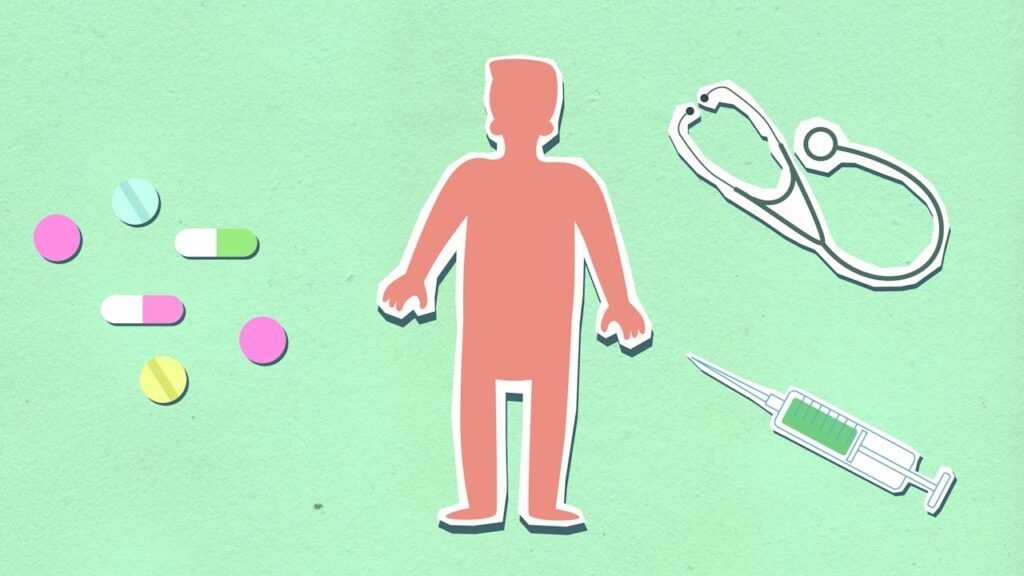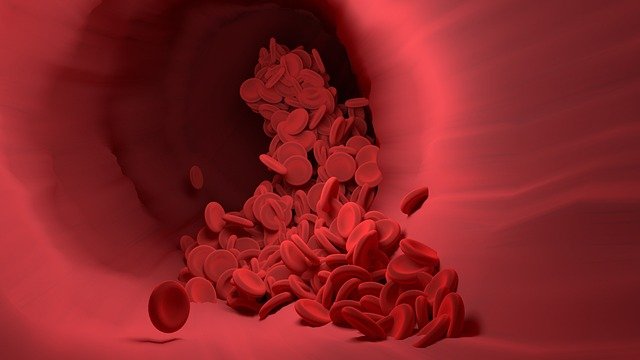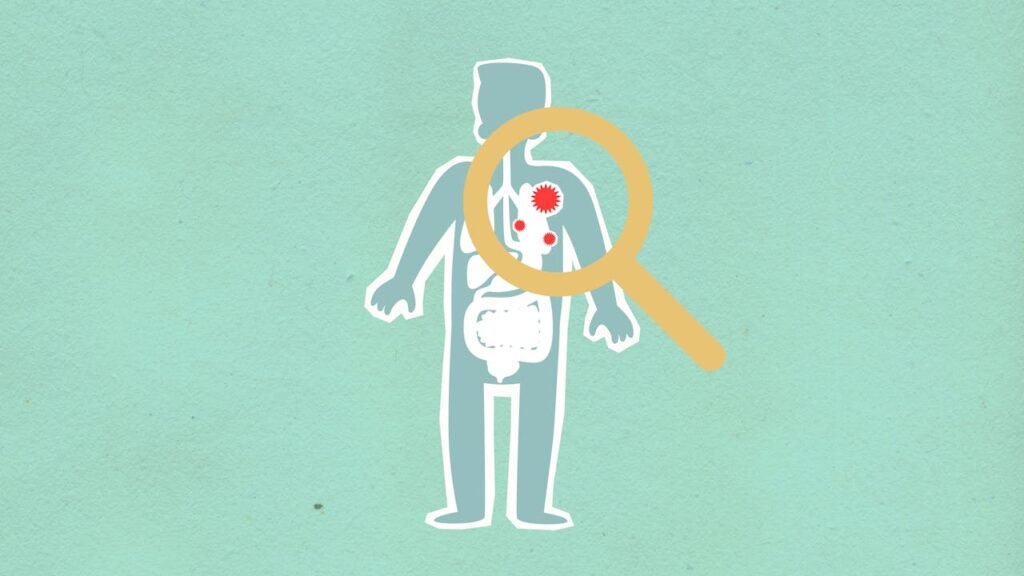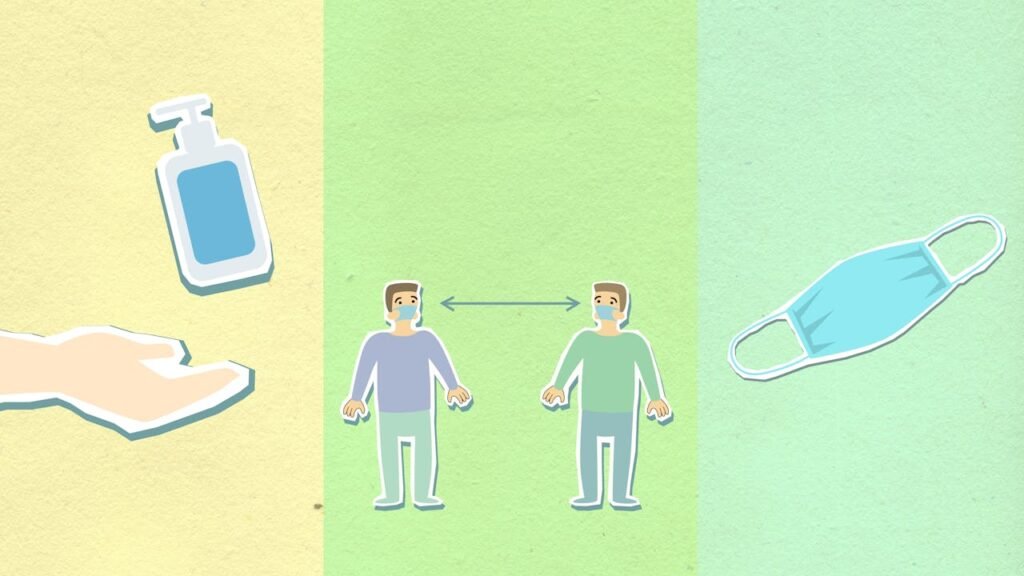Have you ever wondered what happens inside your body when you get a cold or a small cut? Or how your body knows how to fight off the flu, but not your favorite food?
It’s all because of something very smart and powerful inside you—your immune system.
Your immune system is like your body’s own team of superheroes. It watches over you day and night. It looks for anything that doesn’t belong—like germs, viruses, or bacteria—and works hard to get rid of them.
Most of the time, you don’t even know it’s working. That’s how good it is. But when it finds a germ, it jumps into action fast. It’s smart, it’s strong, and it knows what to do.
In this article, we’re going to walk through how your immune system works in a super simple way. We’ll explore how it fights off bad germs, how it learns from past sicknesses, and what you can do every day to help it stay strong.
🧠 What Is the Immune System?
Imagine your body is like a big, busy city. The immune system is the team of protectors that keeps everything safe and running smoothly. It checks who comes in, who stays, and who needs to go.
The immune system is not one single thing. It’s a team made of different parts of your body—like your blood, your skin, your nose, your stomach, your bones, and even your spit. They all work together to do one big job: protect you from getting sick.
Now, let’s talk about the “bad guys” your immune system watches out for. These are tiny things called germs.
Germs are so small you can’t see them, but they’re everywhere—on your hands, in the air, on your toys, and even in the food you eat. Most germs are harmless, and some are even helpful. But a few can make you sick. Those are the ones your immune system fights.
There are different types of germs:
- Bacteria – Some bacteria help your body (like the ones in your tummy that help you digest food), but others cause sickness like sore throats or ear infections.
- Viruses – These are sneaky. They get inside your body and take over your cells to make more of themselves. The cold and flu are caused by viruses.
- Fungi – These can grow in warm, wet places, like between your toes. Ever heard of athlete’s foot? That’s a kind of fungus.
- Parasites – These are tiny creatures that live inside you and steal your food or blood.
Your immune system’s job is to spot these troublemakers—and stop them fast.
🛡️ First Line of Defense: The Body’s Natural Shields

Before any germ even gets inside, your body already has some amazing ways to keep them out. Let’s look at those natural shields one by one.
1. Skin – Your Outside Armor
Your skin is like a big, strong wall that covers your whole body. Germs can’t easily get through it. It’s dry, tough, and always working to block anything dangerous from entering your body.
But if you get a cut or scrape, that wall opens up. That’s when germs can sneak in. Your body quickly sends special cells to close the gap and protect the area.
2. Tears and Saliva – Nature’s Rinse
Your eyes and mouth make special liquids—tears and saliva. These aren’t just for crying or chewing. They’re also little cleaners. They wash away dust, dirt, and germs before they can go deeper.
Your tears even have tiny germ-fighting chemicals in them!
3. Mucus – The Sticky Catcher
Your nose and throat make mucus (you might call it snot!). It’s sticky and thick for a reason—it catches germs and dust before they get into your lungs.
Ever noticed your nose getting stuffy when you’re getting sick? That’s your mucus doing its job—trapping the bad guys.
4. Stomach Acid – The Germ Destroyer
Sometimes, germs get swallowed by accident—maybe from dirty hands or spoiled food. But your stomach has a special acid that is strong enough to kill most of those germs before they can cause trouble.
This means your body has defenders outside and inside, always ready to stop trouble before it begins.
Inside the Body: The Superhero Cells

Okay, so let’s say a sneaky germ makes it past your skin, your tears, your mucus, and even your stomach. It’s inside now.
What happens next?
Your body doesn’t panic. It gets to work. And the heroes are already there—waiting.
These heroes are tiny cells floating in your blood. They’re called white blood cells, and they’re always on patrol, looking for anything that doesn’t belong. Even though they’re very small, they are smart, strong, and super fast. They know how to work together as a team—and each kind of white blood cell has its own job to do.
Let’s meet them.
🧹 1. Macrophages – The Big Eaters
Imagine a big, friendly vacuum cleaner floating around your body. That’s kind of what a macrophage is. Its job is to find the germ, swallow it up, and then send out a message for backup.
Macrophages are often the first to show up when there’s trouble. They gobble up the germ and say, “Hey team, we’ve got an intruder here!”
They also clean up the mess left behind after the battle is over.
Think of them as the body’s clean-up crew and alarm system all in one.
🧠 2. Helper T-Cells – The Team Captains
Next, we have the Helper T-Cells. These cells are like the leaders or team captains. They don’t fight directly, but they are very important. When the macrophages raise the alarm, the helper T-cells figure out what’s going on and then tell the rest of the immune system what to do.
They send messages to other cells like:
- “Get ready to fight!”
- “Start making weapons!”
- “Target this specific germ!”
Without helper T-cells, the immune system wouldn’t know what to do next.
💥 3. Killer T-Cells – The Bodyguards
Now we get to the fighters—the Killer T-Cells. These cells don’t mess around. Their job is to find body cells that have been infected by the germs (especially viruses) and destroy them before the germs can spread.
These cells are smart. They only attack the bad ones—not your healthy cells.
Imagine someone sneaks into your house and hides in a room. The killer T-cell finds them and locks the door tight.
They’re like the immune system’s special forces—trained for one job: protection.
🧪 4. B-Cells – The Antibody Makers
The last member of the team is the B-cell. These are the scientists and inventors of your immune system. They don’t fight the germ directly. Instead, they make antibodies.
What are antibodies?
Antibodies are tiny Y-shaped proteins that stick to germs. Once they stick, they do two things:
- They mark the germ so other cells can spot and destroy it.
- They block the germ from hurting your cells.
Each antibody is like a special key made for one kind of germ. If the same germ tries to come back later, the B-cells remember it—and send the matching antibodies right away.
This is how your body gets stronger every time it fights a sickness.
What Happens When You Get Sick?

So, let’s say you start to feel a sore throat. Your nose is runny. Your head feels heavy. Maybe you’re a little warm. Uh-oh—you’re getting sick.
But what’s really happening inside your body?
Let’s walk through it like a story.
🦠 Step 1: A Germ Sneaks In
You might have touched something with germs on it—like a doorknob or your toy. Maybe you rubbed your eyes or forgot to wash your hands before eating.
A small germ—maybe a virus or bacteria—gets inside your body.
It starts to multiply. That means it makes copies of itself. Fast. It tries to take over your cells and spread.
But don’t worry—your immune system notices right away.
🚨 Step 2: The Alarm Goes Off
The first cells to notice the germ are usually the macrophages. They grab the germ and send out a loud, chemical signal.
This signal says: “We’ve got a problem! Come help!”
Now, more white blood cells rush to the area. It’s like when firefighters get a call and head straight to the scene.
You might start to feel tired or achy here—because your body is starting the fight.
💥 Step 3: The Battle Begins
The killer T-cells and B-cells jump into action.
- The T-cells find cells that are already taken over by the germ and destroy them.
- The B-cells make antibodies—those special protein “tags” that help other immune cells find and destroy the invaders.
This is the part where your symptoms start to show. But here’s the cool part: most symptoms are your body fighting back.
Let’s explain what that means:
- Fever: Your body raises its temperature to make it harder for the germ to survive.
- Coughing or sneezing: Your body is trying to push the germs out.
- Stuffy nose or extra mucus: That’s your body trapping the germs.
- Tiredness: Your energy is going toward the battle—so you feel sleepy or weak.
It might feel uncomfortable, but it’s really your immune system doing its best to protect you.
🛌 Step 4: The Recovery
After a few days, the white blood cells begin to win. The germs stop spreading. Your body starts cleaning up the mess—clearing out the dead germs and healing the cells that got hurt.
You start to feel better.
- Your fever goes down.
- You get your energy back.
- Your nose clears up.
- You’re smiling again!
And here’s something amazing…
🧠 Step 5: Your Body Remembers
The B-cells save a memory of the germ they just fought. That way, if that same germ ever comes back, your immune system can attack it fast and hard—sometimes before you even feel sick.
That’s why you don’t usually get the same sickness twice. Your immune system gets smarter every time it fights.
💪 How to Help Your Immune System Stay Strong

Your immune system is already amazing. But just like a superhero, it needs fuel, rest, and practice to do its best job.
So, how do you take care of your immune system?
It’s not about magic pills or secret potions. It’s about everyday choices—the kind that build your body’s defenses slowly and powerfully.
Here’s how:
🍎 1. Eat Healthy Foods – Feed Your Fighters
Food isn’t just for filling your tummy. It’s how you feed your cells. And your immune system loves certain foods!
Fruits and vegetables are like superfoods for your immune system. They’re full of vitamins and minerals—tiny things your body needs to grow strong cells and fight off germs.
Here are some body-loving foods:
- Oranges, strawberries, and mangoes (rich in vitamin C)
- Carrots and spinach (great for your eyes and skin)
- Yogurt (has good bacteria that help your gut)
- Beans and nuts (give you energy and protein)
🧠 Tip for parents: Make snacks colorful—“Eat the rainbow” helps kids get a variety of nutrients.
😴 2. Get Good Sleep – Rest for Repair
Your body needs sleep like a phone needs charging. At night, your immune system repairs and builds new cells. If you don’t sleep enough, your body can’t fight off germs properly.
Most kids need:
- 10–12 hours of sleep a night (for younger kids)
- 8–10 hours (for teens)
Sleep isn’t lazy. It’s your body getting stronger.
🚶♂️ 3. Move Your Body – Exercise for Energy
You don’t have to run a race or lift weights. Just playing outside, walking, riding a bike, or dancing can wake up your immune system.
Movement helps:
- Pump blood around your body
- Get white blood cells moving
- Lower stress
So go outside and jump, skip, roll, or play tag. It’s good for your heart—and your immune system loves it.
🧼 4. Stay Clean – Wash Away the Germs
Washing your hands is like kicking the germs out before they even get in.
Before meals, after using the toilet, after coughing or sneezing—these are perfect times to wash with soap and water for at least 20 seconds.
It sounds simple, but it works like a charm.
❤️ 5. Keep Your Mind Happy – Stress Makes You Weak
Did you know your feelings can affect your immune system?
When you’re stressed, angry, or worried a lot, your body releases chemicals that make it harder to fight germs.
So it’s important to:
- Talk about your feelings
- Take breaks
- Laugh often
- Spend time with people you love
A happy mind helps make a healthy body.
Bringing It to Life: How Kids Can Explore the Immune System at Home

Learning about the immune system doesn’t stop when class ends. At Debsie, we encourage kids to bring their learning into the real world—because the best science lessons come from everyday life.
Here’s how your child can explore and understand how their immune system works—right from home, with simple tools, big curiosity, and a little imagination.
🗓️ 1. Track a Cold: Turn a Sick Day into a Science Day
When your child catches a cold or feels a little off, it’s actually a golden chance to learn how the immune system works in real-time.
Here’s how to make it educational (and comforting!):
- Day 1: Ask them to write or draw how they feel. Is their nose runny? Are they sneezing? Explain that this is their immune system’s way of pushing out the germs.
- Each Day After: They can keep a simple “Immune System Diary”—writing what they did that day (slept more, drank soup, washed hands), how their symptoms changed, and what helped.
- Recovery Day: Celebrate when they feel better—and explain how their white blood cells fought hard and now they’re stronger than before.
This helps children see illness not as something scary—but as a natural part of how the body learns and grows.
🧪 2. Do a Simple Germ Experiment with Bread
This classic hands-on activity helps kids see how germs spread—and why handwashing is so important.
You’ll need:
- 3 slices of white bread
- 3 clear plastic sandwich bags
- A marker for labeling
Step-by-step:
- Take one slice of bread with clean hands (washed with soap) and place it in a bag. Label it “Clean Hands.”
- Take another slice with unwashed hands (touch things around the room first!) and put it in a second bag. Label it “Dirty Hands.”
- Use tongs or gloves for the third slice—no human touch at all. Label this one “Untouched.”
Seal all bags and place them in a warm spot (like a windowsill). Check them daily.
Watch what happens—the “dirty hands” bread will show mold first! This simple test shows that germs are real, and soap works.
🎨 3. Create a “White Blood Cell” Squad with Crafts
Kids love superheroes. So let’s make the immune system a team of real-life heroes.
Let your child:
- Use paper, clay, playdough, or cardboard to design different immune system characters
- Name them: “Captain Macrophage,” “Blast-B-Cell,” or “Commander T-Cell”
- Add powers: “Blasts antibodies!” or “Eats germs whole!”
They can even make a comic book or short skit about how the body fights germs. This lets them take what they’ve learned and create something from their own imagination.
🧼 4. Set Up a Handwashing Science Station
Make hygiene fun and science-based. Use glitter to show how germs spread:
- Put a bit of glitter on your child’s hand.
- Ask them to shake hands with someone, touch toys, or grab a doorknob.
- Then, check how far the glitter goes!
Now try washing hands with just water, then again with soap and water.
They’ll see that soap breaks down the “germs” much better. This makes handwashing not just a rule—but a science-backed superhero move.
🧠 5. Watch, Wonder, and Talk
Sometimes the best learning comes from good questions. At Debsie, we always encourage kids to talk about what they’re learning.
You can help by asking:
- “Why do you think your body gets a fever?”
- “What do you think white blood cells look like?”
- “If your immune system were a cartoon team, who would be the leader?”
These chats make learning personal and keep the ideas fresh in their minds.
📺 You can also pair this with short animated videos or books about the body. Debsie’s curated learning library includes trusted, age-friendly resources that explain big science ideas in small, fun ways.
How Debsie Helps Kids Learn About the Immune System
The immune system is big, complex, and full of tiny things we can’t even see. But at Debsie, we know how to turn something that feels invisible into something children can really understand, explore, and get excited about.
We don’t believe in boring slides or long lectures.
Instead, we help kids see, feel, and interact with science.
Here’s how we do it:
👩🏫 1. Live Teacher-Led Classes That Feel Like a Science Adventure
Our immune system lessons are taught by real teachers who are not only subject experts—they’re amazing with kids.
In these classes, kids:
- Watch fun, clear demos about how germs enter the body
- Explore real photos, body diagrams, and animated videos that show white blood cells in action
- See how a fever works, what antibodies look like, and why their body gets stuffy when they’re sick
- Join discussions and ask questions freely—no pressure, no judgment
Our teachers break down big ideas into tiny steps that make perfect sense. Even a 6-year-old can understand how a B-cell makes antibodies when it’s explained the Debsie way.
🎮 2. Gamified Learning That Makes Science Feel Like Play
At Debsie, we use games and storytelling to teach serious science.
In our immune system topics, kids might:
- Play a role as a white blood cell fighting off invaders
- Go on a digital “Germ Hunt Quest” where they find and fight different germs using what they’ve learned
- Earn science badges and points for completing missions like “Build Your Own Immune Squad” or “Decode the Fever”
These aren’t just games—they’re smart, interactive lessons that build memory and critical thinking.
Kids don’t even realize they’re learning… because they’re having so much fun doing it.
✏️ 3. Creative Projects That Help Kids Think Like Scientists
We believe science sticks better when kids use their hands and make things.
That’s why we include:
- Simple DIY immune system models (build-your-own white blood cell armies!)
- Sketching activities where kids draw each stage of fighting an infection
- Real-life observation logs: “What happens when I get a cold?” (yes, even your child’s last sick day can turn into a science project!)
These activities help kids connect what they learn to their own bodies—making learning feel personal and powerful.
🌍 4. All Ages, All Levels, All Learning Styles Welcome
Whether your child is 5 or 15, just starting out or already science-obsessed—Debsie has a course for them.
Our programs are built to support every learner:
- Visual learners see animations and models.
- Auditory learners listen to expert storytelling.
- Hands-on learners do mini experiments and projects.
- Curious minds ask deep questions—and always get answers.
At Debsie, we treat every child like a natural-born scientist. We build their confidence while building their knowledge.
Final Thoughts: Building Strong Bodies and Even Stronger Minds
The immune system is one of the most incredible things inside our bodies. It works all day, every day—protecting us, healing us, and learning with us.
When children understand how their immune system works, they don’t just learn science. They learn how to take care of themselves. They grow more curious, more confident, and more in tune with their own bodies.
And that’s the kind of learning that lasts forever.
At Debsie, we bring these ideas to life—through fun science lessons, real experiments, creative projects, and inspiring teachers who make complex topics feel simple, exciting, and personal.
Whether your child is five or fifteen, shy or super curious, Debsie will meet them right where they are—and help them grow.
🚀 Ready to Help Your Child Explore Their Body, Their Brain, and Their World?
👉 Sign up for a FREE trial class today – let your child experience joyful, real learning firsthand.
👉 Browse our full range of science and STEM programs here – made for kids aged 5 to 18.
👉 Give your child a classroom that sparks wonder—and a future built on confidence, curiosity, and clear thinking.
Because when kids understand how their body works, they’re not just healthier.
They’re smarter, stronger, and ready for anything.
Read next:
